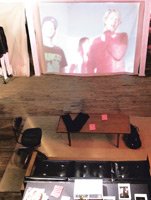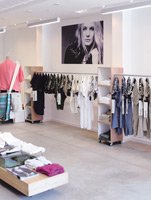Pop-Up Shops Looking Permanent
The weak economy is beginning to make temporary, glitzy pop-up shops look like a solid deal.
With commercial vacancy increasing in the past year, more landlords have been receptive to the idea of putting a pop-up shop on their properties. Even if these boutiques are temporary, they could keep the lights on at their malls, keeping vacancy at bay. In fact, pop-up shops have been turning up at the top-level malls and on most fashionable retail streets.
On Aug. 1, Gap Inc. produced a pop-up store on Los Angeles’ high-profile Robertson Boulevard. Just one year ago, there was no vacancy on the street, which is the address of an exclusive Chanel store and a Ralph Lauren boutique. According to real estate broker Jay Luchs, many landlords began taking pop-up shops more seriously after the recession started getting rough in 2008.
“It does fill a land void for landlords,” said Luchs, vice president of commercial real estate brokerage CB Richard Ellis. “But the tenants often get a cheaper deal on a great street and a chance to see how they can do in a specific market.” More manufacturers and retailers say the pop-up shop has become an increasingly attractive option—and they contend these temporary shops can make money. It’s a long way from the beginnings of the pop-up shop. A few years ago, such shops were often considered nothing more than flashy marketing vehicles meant to pique the interest of the media and in-the-know consumers. They promised exclusive merchandise, limited availability of the special goods and novel locations such as a boat or a warehouse. They were not primarily intended to be money makers.
Sanctuary Clothing is one business finding profit in pop-ups. The Los Angeles–based fashion label produced its first pop-up shop at the exclusive Malibu Lumber Yard shopping center in Malibu, Calif., on June 26. According to label President Ken Polanco, by its seventh day of business, the store’s earnings covered its rent for the 10-week lease.
He did not divulge how much money the store earned, but he contended the Sanctuary boutique succeeded because of the classic pop-up-shop formula. Shoppers are typically willing to open their wallets if they are offered a novel product with a limited availability, he said.
Another entrepreneur finding money in pop-up shops is Los Angeles–based Christos Garkinos. He produced a pop-up-shop version of his designer consignment boutique Decades Two in New York for four days in May. He forecast only 1,000 people would shop at his pop-up shop. But more than 2,000 people visited the shop, located in a 1,200-square-foot space on top of the Kiki de Montparnasse boutique in New York’s SoHo district.
Garkinos did not divulge how much money the pop-up shop earned. But he did say it earned more in four days than what Decades Two made in its first year in business in 1999. The average expenditure at the pop-up was $400. Many of Decades Two pop-up designer items were priced at 80 percent off the retail price. Because of the success of the temporary New York boutique, Decades Two will produce a handful of pop-up shops in locations outside of Los Angeles annually, Garkinos said.
However, one of the most powerful reasons to produce a pop-up shop remains marketing and spreading the word on a product. Costa Mesa, Calif.–based brand Comune opened a pop-up shop in New York boutique Inven.tory with the mission of putting the year-old brand on the radar screens of New York’s fashion crowd.
The 500-square-foot Comune pop-up shop debutedJuly 22, just as the influential trade show Capsule wrapped up its New York show. Comune founder Frank Delgadillo said show buyers cruised over to Inven.tory to check out how Comune could be merchandised in a store. Inven.tory featured Comune product in its store windows and devoted e-mail blasts to the brand. It closed Aug. 22. Delgadillo said he believes the shop has already helped register the brand on the radar screens of consumers in a very important market. In this case, profit will be icing on the cake.
“[Pop-up shops] are marketing ploys,” he said. “If you break even, it’s a job well done.” The construction of a pop-up shop can cost as much as building a well-appointed booth at a trade show, perhaps more than $10,000, Delgadillo said.
Testing the retail waters
A pop-up shop’s profitability is a crucial matter to Jeff Dodd, senior vice president of leasing for Irvine Retail Properties Co., the owner of the Fashion Island retail center in Newport Beach, Calif. Recently, Irvine Co. leasing agents have talked more about the possibility of putting a pop-up shop on one of the company’s properties. There are no pop-up shops on its properties now.
“It should have the same criteria as a permanent store,” Dodd said. “It’s about the quality of the goods, the excitement that the store brings and making a connection with the customer.” Dodd said his agents consider pop-up shops as nothing more than a chance for a company to dip its toes into retail waters. If a pop-up shop is proven to be a financial success, it would be logical for the landlord to encourage the owners of a pop-up shop to make the shop permanent.
Pop-up shops can brighten up a retail center—or sully its image, said Shaheen Sadeghi, owner of Costa Mesa, Calif.–based specialty shopping centers The Camp and The Lab.
“Retail has been so predictable for so long that a pop-up shop can add some much-needed urgency,” Sadeghi said. “Since it’s not a permanent situation, the tenant can have more fun; they can put an art-installation angle to it.”
However, if the pop-up shop is not executed well, it can tarnish a retail center’s reputation and even drive shoppers away, he said.
Landlords might have to get used to the notion of the pop-up shop, said Larry Kosmont, president of downtown Los Angeles–based real estate advisory group Kosmont Cos.
If national retailers continue to cut back on expansion, landlords will have to become more creative in looking for tenants. Prospective tenants could include retailers that landlords have not considered seriously in the past. “There will be a lot more openness when they look for retailers,” Kosmont said.
























